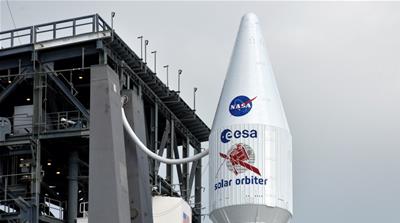Peering at the sun: Solar Orbiter probe set for launch
In less than two years, scientists expect to receive the first-ever images of, and data about, the sun’s poles.

While tens of millions of people worldwide watch the 92nd Academy Awards on Sunday, cheering on their favourite film stars, NASA and the European Space Agency (ESA) will be counting down the minutes until they launch their probe to the Earth’s only star, the sun.
At 11:03pm Eastern United States time (04:03 GMT) an Atlas V rocket will blast off from Space Launch Complex 41 at Florida’s Cape Canaveral Air Force Station carrying NASA and ESA’s Solar Orbiter spacecraft.
Keep reading
list of 3 itemsElon Musk wants you to be his next space-based customer
Is Trump’s moonshot heading for a roadblock?
At first blush, the orbiter’s $1.5bn price tag may seem steep, but getting a better understanding of how solar storms form and gather strength before they pummel the earth and fry the very technology many have come to depend on could save trillions of more dollars here on Earth.
“The data from missions like this creates predictive models so that we’ll be able to protect our astronauts, [and] protect our assets,” said Alan Zide, NASA’s Solar Orbiter program executive, at a Friday news conference.
The risk
Because the risk to assets and astronauts is real, the insurance brokerage Lloyds of London released a report in 2013 on the possible effects of a monster solar storm, called a Carrington event, on the United States.

The Lloyds analysts found that: “The total US population at risk of extended power outage from a Carrington-level storm is between 20-40 million, with durations of 16 days to 1-2 years.”
They concluded: “The total economic cost for such a scenario is estimated at $0.6-2.6 trillion USD.”
Compare that to the cost of the 2008 US financial crisis. The Emergency Economic Stabilization Act of 2008, which helped to bail out the US financial system, cost the taxpayer $634bn, according to Propublica’s Bailout Tracker.
That sounds insane but just think about the scope of the goods and services that depend on electricity, such as ATMs, gas pumps and cellphone towers. Not to mention that the very satellites that make financial transactions possible and make telephonic and internet communication possible, could be disabled.
How can this happen?
Similar to how weather disturbances off the northwest coast of Africa can potentially morph into devastating hurricanes in the Caribbean, sun storms can grow large clouds too. But these clouds are packed with magnetised particles called plasma.
A coronal mass ejections (CME) is an immense plasma cloud that the sun ejects, hurling billions of tons of magnetised particles in one direction at the rate of a million miles per hour. If Earth is in the CME’s path, it will be hit with an enormous amount of plasma within three days.
On September 1, 1859 a CME named the Carrington Event after an amateur astronomer who witnessed it, caused telegraph machines around the world to fail and spark, setting papers on fire. On a Friday, March 13, 1989, some six million people in northeastern Canada were in the dark for nine hours because the utility’s grid suffered a power overload caused by a CME.
What’s on board?
The Solar Orbiter is carrying a mix of 10 instruments from different countries that will measure the space environment near the sun and image the star’s fiery atmosphere. Unlike previous missions, these instruments can talk to each other. At the Friday news conference Cesar Garcia, ESA’s Solar Orbiter project manager, said: “They are able to talk to each other so that when one of the instruments detects an interesting feature, it can then send a flag, a trigger, to the other instruments to co-observe that same feature.”
If the mission is successful, the Solar Orbiter will get the first-ever images of, and data from, the sun’s polar regions. According to ESA, the spacecraft will reach the sun in just under two years.